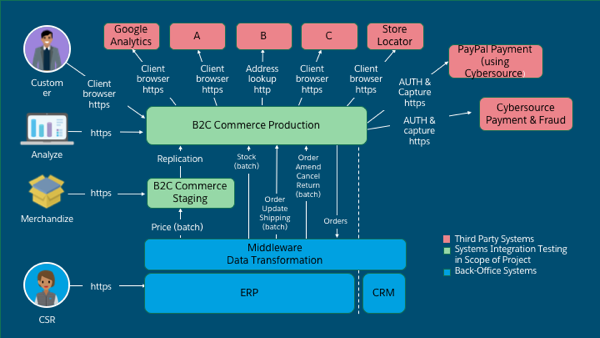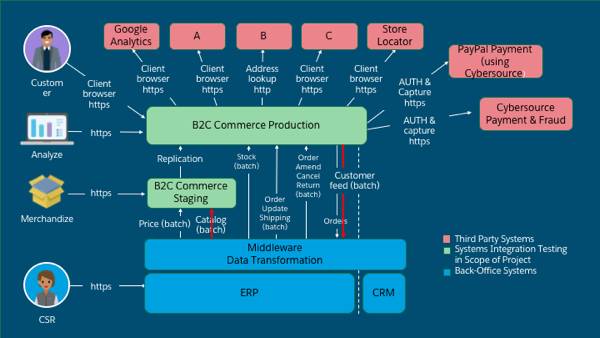Create an Architecture Diagram
Learning Objectives
After completing this unit, you’ll be able to:
- Explain why an architecture diagram is important.
- List an important data format.
- List the three types of systems that should be included in the architecture diagram.
- Explain why you should use HTTPS instead of HTTP.
Introduction
The architecture diagram provides a visual overview of what’s included in the implementation. Create it as early as possible to make sure that all your integrations are fully thought out. The architecture diagram gives everyone on the team a complete picture of the relationships between Salesforce B2C Commerce systems, LINK technology, and other third-party systems, such as the client’s enterprise resource planning system (ERP) or product information management (PIM).
The Big Picture
This architecture diagram shows the various integrations required in a sample implementation. It’s important to fully document all third-party connection requirements within the diagram or on attached pages, so you don’t overlook anything.

This diagram differentiates three types of systems: B2C Commerce, third-party, and back-end (or systems of record). The B2C Commerce staging and production instances have different functions within the flow of data. In this sample, back-end systems include middleware (data transformation), ERP, and customer relationship management (CRM).
The example implementation integrates several third-party applications with the B2C Commerce production instance.
- Google Analytics: Free and enterprise analytics tools to measure website, app, digital, and offline data to gain customer insights
- A: Ad personalization platform, such as Struq, that delivers sales to ecommerce advertisers through personalized retargeting
- B: Comprehensive data quality software (think address verifications), such as Experian EDQ
- C: Affiliate marketing network, such as Rakuten Marketing
- Store Locator: Software from any number of vendors that provides store locator functionality
- PayPal Payment: Online payments system for online money transfers that serves as an electronic alternative to traditional paper methods such as checks and money orders
- Cybersource: Ecommerce credit card payment system management for online payments, fraud management, and payment security
Third-Party Integration: HTTPS or HTTP?
HTTPS versus HTTP is an important security consideration. Although a customer or shopper accesses the B2C Commerce production instance via HTTPS, many third-party systems, with the exception of PayPal and Cybersource, don't require HTTPS and typically access the instance via HTTP.
Some third-party products use other integration methods. Address look-up typically involves a synchronous request/reply via HTTP. PayPal and Cybersource, both with authorization and capture capabilities, also use synchronous request/reply, but via HTTPS for added security. Communications with payment service providers should always be via HTTPS (including SSL verification). PayPal force/upgrades to HTTPS.
We recommend that all connections use HTTPS for improved security. This includes applications that don’t require it.
Back-End Integration
The data flow from a production instance to a back-end system depends on where the data is created. Typically, data flows via a batch process in the B2C Commerce XML format using SFTP.
In the example implementation, a middleware application connects your on-premises systems to cloud-based applications. Stock or inventory data and price data are created on the system of record. Post-checkout order data such as shipping updates, order amends, cancels, and returns are also created on the system of record. The orders themselves are captured on the B2C Commerce production instance, then exported to the system of record.
Data Flow and Formats
When creating your diagram, make sure to identify data flows and formats at a high level. For example, define the flow of inventory data to and from the B2C Commerce instance and the client’s PIM systems, along with the import/export data format required.
Where’s the Gap
When you review the example diagram, you might notice that two key data flows are missing, namely catalog and customer data. Here’s where those data flows fit into the diagram.
- Catalog data feeds in a batch process from the data transformation layer to B2C Commerce staging
- Customer data feeds in a batch process from B2C Commerce production to the data transformation layer
